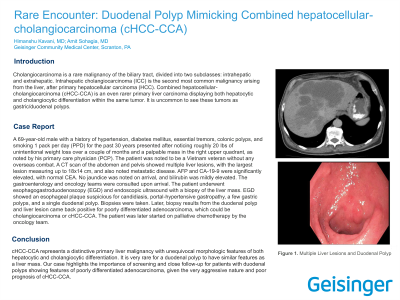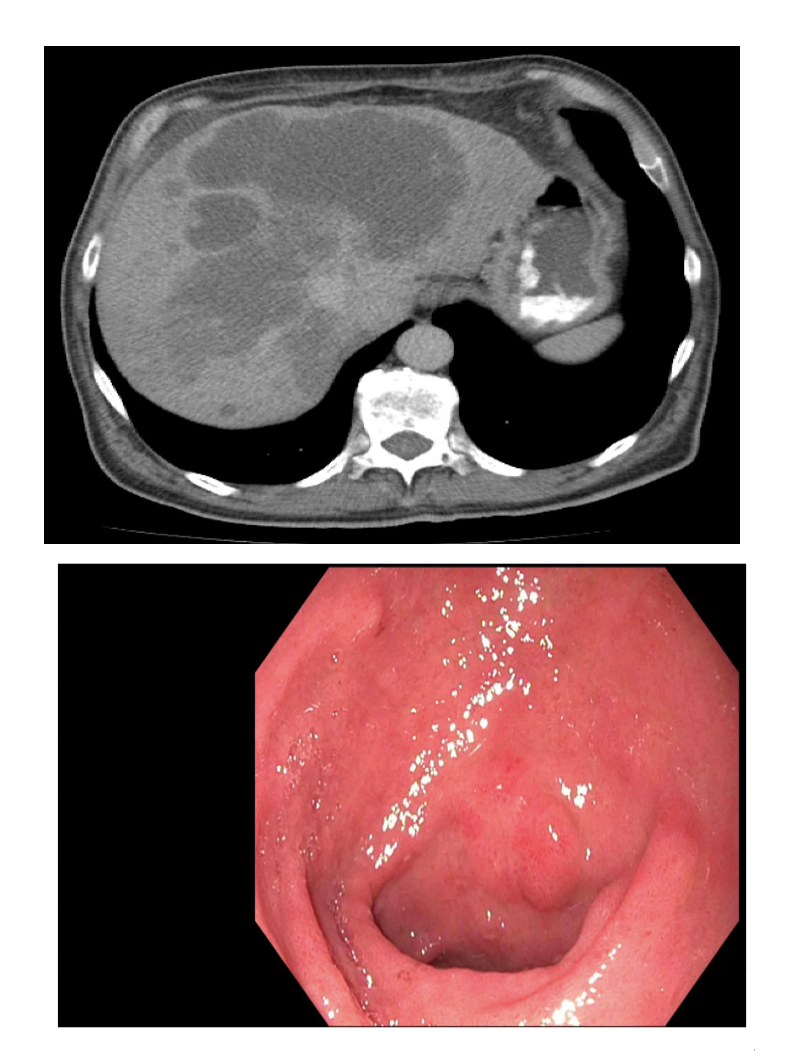Tuesday Poster Session
Category: Biliary/Pancreas
P3503 - Rare Encounter: Duodenal Polyp Mimicking Combined Hepatocellular Cholangiocarcinoma
Tuesday, October 29, 2024
10:30 AM - 4:00 PM ET
Location: Exhibit Hall E

Has Audio

Himanshu Kavani, MD
Geisinger Community Medical Center
Old Forge, PA
Presenting Author(s)
Himanshu Kavani, MD1, Amit Sohagia, MD2
1Geisinger Community Medical Center, Old Forge, PA; 2Geisinger Community Medical Center, Scranton, PA
Introduction: Cholangiocarcinoma is a rare malignancy of the biliary tract, divided into two subclasses: intrahepatic and extrahepatic. Intrahepatic cholangiocarcinoma (ICC) is the second most common malignancy arising from the liver, after primary hepatocellular carcinoma (HCC). Combined hepatocellular-cholangiocarcinoma (cHCC-CCA) is an even rarer primary liver carcinoma displaying both hepatocytic and cholangiocytic differentiation within the same tumor. It is uncommon to see these tumors as gastric/duodenal polyps.
Case Description/Methods: A 69-year-old male with a history of hypertension, diabetes mellitus, essential tremors, colonic polyps, and smoking 1 pack per day (PPD) for the past 30 years presented after noticing roughly 20 lbs of unintentional weight loss over a couple of months and a palpable mass in the right upper quadrant, as noted by his primary care physician (PCP). The patient was noted to be a Vietnam veteran without any overseas combat. A CT scan of the abdomen and pelvis showed multiple liver lesions, with the largest lesion measuring up to 18x14 cm, and also noted metastatic disease. AFP and CA-19-9 were significantly elevated, with normal CEA. No jaundice was noted on arrival, and bilirubin was mildly elevated. The gastroenterology and oncology teams were consulted upon arrival. The patient underwent esophagogastroduodenoscopy (EGD) and endoscopic ultrasound with a biopsy of the liver mass. EGD showed an esophageal plaque suspicious for candidiasis, portal-hypertensive gastropathy, a few gastric polyps, and a single duodenal polyp. Biopsies were taken. Later, biopsy results from the duodenal polyp and liver lesion came back positive for poorly differentiated adenocarcinoma, which could be cholangiocarcinoma or cHCC-CCA. The patient was later started on palliative chemotherapy by the oncology team
Discussion: cHCC-CCA represents a distinctive primary liver malignancy with unequivocal morphologic features of both hepatocytic and cholangiocytic differentiation. It is very rare for a duodenal polyp to have similar features as a liver mass. Our case highlights the importance of screening and close follow-up for patients with duodenal polyps showing features of poorly differentiated adenocarcinoma, given the very aggressive nature and poor prognosis of cHCC-CCA

Disclosures:
Himanshu Kavani, MD1, Amit Sohagia, MD2. P3503 - Rare Encounter: Duodenal Polyp Mimicking Combined Hepatocellular Cholangiocarcinoma, ACG 2024 Annual Scientific Meeting Abstracts. Philadelphia, PA: American College of Gastroenterology.
1Geisinger Community Medical Center, Old Forge, PA; 2Geisinger Community Medical Center, Scranton, PA
Introduction: Cholangiocarcinoma is a rare malignancy of the biliary tract, divided into two subclasses: intrahepatic and extrahepatic. Intrahepatic cholangiocarcinoma (ICC) is the second most common malignancy arising from the liver, after primary hepatocellular carcinoma (HCC). Combined hepatocellular-cholangiocarcinoma (cHCC-CCA) is an even rarer primary liver carcinoma displaying both hepatocytic and cholangiocytic differentiation within the same tumor. It is uncommon to see these tumors as gastric/duodenal polyps.
Case Description/Methods: A 69-year-old male with a history of hypertension, diabetes mellitus, essential tremors, colonic polyps, and smoking 1 pack per day (PPD) for the past 30 years presented after noticing roughly 20 lbs of unintentional weight loss over a couple of months and a palpable mass in the right upper quadrant, as noted by his primary care physician (PCP). The patient was noted to be a Vietnam veteran without any overseas combat. A CT scan of the abdomen and pelvis showed multiple liver lesions, with the largest lesion measuring up to 18x14 cm, and also noted metastatic disease. AFP and CA-19-9 were significantly elevated, with normal CEA. No jaundice was noted on arrival, and bilirubin was mildly elevated. The gastroenterology and oncology teams were consulted upon arrival. The patient underwent esophagogastroduodenoscopy (EGD) and endoscopic ultrasound with a biopsy of the liver mass. EGD showed an esophageal plaque suspicious for candidiasis, portal-hypertensive gastropathy, a few gastric polyps, and a single duodenal polyp. Biopsies were taken. Later, biopsy results from the duodenal polyp and liver lesion came back positive for poorly differentiated adenocarcinoma, which could be cholangiocarcinoma or cHCC-CCA. The patient was later started on palliative chemotherapy by the oncology team
Discussion: cHCC-CCA represents a distinctive primary liver malignancy with unequivocal morphologic features of both hepatocytic and cholangiocytic differentiation. It is very rare for a duodenal polyp to have similar features as a liver mass. Our case highlights the importance of screening and close follow-up for patients with duodenal polyps showing features of poorly differentiated adenocarcinoma, given the very aggressive nature and poor prognosis of cHCC-CCA

Figure: Multiple Liver Lesions and Duodenal Polyp
Disclosures:
Himanshu Kavani indicated no relevant financial relationships.
Amit Sohagia indicated no relevant financial relationships.
Himanshu Kavani, MD1, Amit Sohagia, MD2. P3503 - Rare Encounter: Duodenal Polyp Mimicking Combined Hepatocellular Cholangiocarcinoma, ACG 2024 Annual Scientific Meeting Abstracts. Philadelphia, PA: American College of Gastroenterology.
